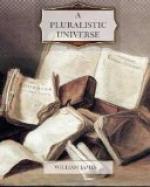Volumes i, ii, and iii of the Monist (1890-1893) contain a number of articles by Mr. Charles S. Peirce, articles the originality of which has apparently prevented their making an immediate impression, but which, if I mistake not, will prove a gold-mine of ideas for thinkers of the coming generation. Mr. Peirce’s views, tho reached so differently, are altogether congruous with Bergson’s. Both philosophers believe that the appearance of novelty in things is genuine. To an observer standing outside of its generating causes, novelty can appear only as so much ‘chance’; to one who stands inside it is the expression of ‘free creative activity.’ Peirce’s ‘tychism’ is thus practically synonymous with Bergson’s ‘devenir reel.’ The common objection to admitting novelties is that by jumping abruptly in, ex nihilo, they shatter the world’s rational continuity. Peirce meets this objection by combining his tychism
[Footnote 1: Compare the douma with what Perry aimed at.]
[Footnote 2: Compare Appendix B, as to what I mean here by ‘real’ casual activity.]
with an express doctrine of ‘synechism’ or continuity, the two doctrines merging into the higher synthesis on which he bestows the name of ’agapasticism (loc. cit., iii, 188), which means exactly the same thing as Bergson’s ‘evolution creatrice.’ Novelty, as empirically found, doesn’t arrive by jumps and jolts, it leaks in insensibly, for adjacents in experience are always interfused, the smallest real datum being both a coming and a going, and even numerical distinctness being realized effectively only after a concrete interval has passed. The intervals also deflect us from the original paths of direction, and all the old identities at last give out, for the fatally continuous infiltration of otherness warps things out of every original rut. Just so, in a curve, the same direction is never followed, and the conception of it as a myriad-sided polygon falsifies it by supposing it to do so for however short a time. Peirce speaks of an ‘infinitesimal’ tendency to diversification. The mathematical notion of an infinitesimal contains, in truth, the whole paradox of the same and yet the nascent other, of an identity that won’t keep except so far as it keeps failing, that won’t transfer, any more than the serial relations in question transfer, when you apply them to reality instead of applying them to concepts alone.
A friend of mine has an idea, which illustrates on such a magnified scale the impossibility of tracing the same line through reality, that I will mention it here. He thinks that nothing more is needed to make history ‘scientific’ than to get the content of any two epochs (say the end of the thirteenth and the end of the nineteenth century) accurately defined, then accurately to define the direction of the change that led from the one epoch into the other, and finally to prolong the line of that direction




